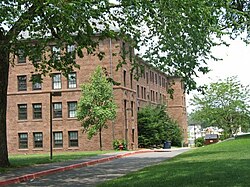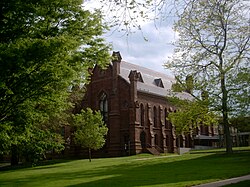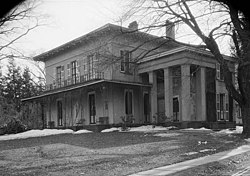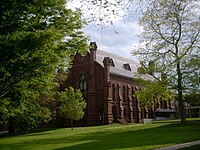Wesleyan University
This article contains promotional material. (July 2023) ) |
President Michael S. Roth | | |
| Provost | Nicole Stanton | |
|---|---|---|
Academic staff | 430 (fall 2020)[3] | |
| Students | 3,053 (fall 2020)[3] | |
| Undergraduates | 2,852 (fall 2020)[3] | |
| Postgraduates | 201 (fall 2020)[3] | |
| Location | , United States 41°33′20″N 72°39′21″W / 41.5556°N 72.6558°W | |
| Campus | Small city, 360 acres (150 ha) | |
| Student newspaper | The Wesleyan Argus | |
| Colors | Cardinal and black[4] | |
| Nickname | Cardinals | |
Sporting affiliations | ||
| Website | www | |
 | ||
Wesleyan University (/ˈwɛsliən/ ⓘ WESS-lee-ən) is a private liberal arts university in Middletown, Connecticut, United States. It was founded in 1831 as a men's college under the Methodist Episcopal Church and with the support of prominent residents of Middletown. It is currently a secular institution.
The college accepted female applicants from 1872 to 1909, but did not become fully co-educational until 1970. Before full co-education, Wesleyan alumni and other supporters of women's education established
History

Before Wesleyan was founded, a military academy established by Captain
The Wesleyan student body numbered about 300 in 1910[15] and had grown to 800 in 1960.[16]
Wesleyan is, along with Amherst and Williams colleges, a member of the Little Three. Wesleyan began as the smallest of the three. Later on, it expanded its programs, qualifying as a university with a variety of graduate offerings and eventually becoming larger than the other two.[17][18]

In 1872, the university became one of the first U.S. colleges to attempt
Wesleyan became independent of the Methodist church in 1937. In 2000, the university was designated as a historic Methodist site.[21]
Beginning in the late 1950s, president
The building program begun under this system created three residential colleges on Foss Hill (the Foss Hill dormitories), followed by three more residential colleges (the Lawn Avenue dormitories, now called the Butterfield Colleges). Although the structures were built, only four of the proposed academic programs were begun. Two of those continue today: the College of Letters and the College of Social Studies.[16][23] Butterfield proved effective at fund raising: by 1960 Wesleyan had the largest endowment, per student, of any college or university in America, and a student-faculty ratio of 7:1.[26]
Butterfield's successors, Edwin Deacon Etherington (class of 1948)[27] and Colin Goetze Campbell,[28] completed many of the innovations begun during Butterfield's administration, including the return of women in numbers equal to men;[29] a quadrupling in the total area of building space devoted to laboratory, studio, and performing arts instruction; and a significant rise in racial, ethnic, and religious diversity and total number of students.[27][30][31][32][33]
The university and several of its admissions deans were featured in Jacques Steinberg's 2002 book The Gatekeepers: Inside The Admissions Process of a Premier College.[34][35] In the fall 2007 semester, Michael S. Roth, a 1978 graduate of Wesleyan and former president of the California College of the Arts, was inaugurated as the university's 16th president.[36]
Campus
Wesleyan occupies a 360-acre (1.5 km2) campus, with over 340 buildings, including the five-building College Row;
When Wesleyan University was founded in 1831, it took over a campus on which two buildings, North College and South College, had already been built in 1825. They were originally constructed by the City of Middletown for use by Captain Partridge's American Literary, Scientific, and Military Academy. In 1829, after the Connecticut legislature declined it a charter to grant college degrees, Capt. Alden Partridge moved his academy to Northfield, Vermont. The academy later became Norwich University and the Middletown buildings were acquired by Wesleyan. The book, Norwich University, 1819-1911, Vol. I (1911), provides the following description of South College (originally called the Lyceum) and North College (called the Barracks).[39]

These structures were constructed out of brown sandstone that was mined from quarries in Portland, Connecticut. The "Barracks" was four stories high, 150 feet long and 52 feet wide, with a large attic and basement. The "Lyceum" was located 20 feet south of the Barracks, was three stories high, with a basement partly above the ground. At the front of the building was a tower 14×16 feet and 73 feet high. The third floor was called the "Hall of the Lyceum" and used as a chapel, a drill room, and for public services.[40]
The original North College was destroyed in a fire in 1906, but South College survived, being converted into offices that same year. The cupola and the belfry, which contains the Wesleyan Carillon, was designed by Henry Bacon and was added in 1916.[41]
The original core buildings of the campus were North College and South College. North College, a Nassau Hall-type building seen in most early American college campuses, was replaced after a fire in 1909 with the current North College. South College is the sole building from the beginning of the college.
The northern end of High Street contains several large buildings that were former private residences, a few of which were exceptional architectural examples. These include

Recent building initiatives include the Freeman Athletic Center; the Center for Film Studies; and a multibuilding renovation project creating a Humanities District on the east side of High Street. The Allbritton Center opened in the fall of 2009 and houses the Allbritton Center for the Study of Public Life, the Shapiro Creative Writing Center, the Quantitative Analysis Center, and the Feminist, Gender, and Sexuality Studies Program.[44][45]
Undergraduate academics
This section may contain an excessive number of citations. (July 2023) |
Wesleyan's 46 undergraduate academic departments offer over 900 courses each semester and more than 900 individual tutorials.[46][47] Wesleyan also offers 13 interdisciplinary programs and nine Academic Centers.[48][49][50][51] Undergraduates receive the Bachelor of Arts in one (or more) of 45 major concentrations.[52][53][54] Wesleyan began offering minors in February 2012 and at present offers eleven minors.[55][56] Certificates are offered in eleven fields.[55] Wesleyan allows students to take double and triple majors, and 40% of Wesleyan graduates take double majors.[57][58] Undergraduates can also pursue a custom-designed major, known as a University Major.[59]
Wesleyan offers
Wesleyan does not require undergraduates to take prescribed courses.[68][69] Freshmen are offered First Year Initiative seminars, which are designed to prepare them for upper-level courses by emphasizing writing, analysis, discussion, and critical thinking.[70] Undergraduates are encouraged in the first two years of study to take a minimum of two courses from two different departments in each of three areas: natural sciences and mathematics, humanities and the arts, and social and behavioral sciences.[71] In the second two years, undergraduates are expected to take one course in each of these three areas. "A student who does not meet these [general education] expectations by the time of graduation will not be eligible for University honors, Phi Beta Kappa, honors in general scholarship [honors or high honors], and for honors in certain departments."[57][72]
Its most popular undergraduate majors, based on 2021 graduates, were:[73]
- Econometrics and Quantitative Economics (67)
- Psychology (65)
- Political Science and Government (64)
- English Language and Literature (48)
- Behavioral Neuroscience (38)
- Film/Cinema/Media Studies (38)

Bailey College of the Environment
The Bailey College of the Environment (COE), created in 2009, integrates the following components: 1) a curricular component, including the newly established environmental studies major, the environmental studies certificate, and a senior capstone project; 2) a
College of Film and the Moving Image
The university's Film Studies program is led by film historian
In February 2013, Wesleyan announced the creation of a new College of Film and the Moving Image, incorporating the Film Studies Department, the Center for Film Studies, the Cinema Archives and the Wesleyan Film Series.[83]
College of Integrative Sciences
The College of Integrative Sciences (CIS) is the most recent interdisciplinary college at Wesleyan, founded in 2014. The CIS provides students with an interdisciplinary education in the sciences, and combines it with hands-on problem solving skills in research. To build interdisciplinary expertise, students must complete both a traditional major in science or mathematics, as well as a "linked" major that combines components from other disciplines to form a coherent plan of study.[84]
College of Letters
The College of Letters (COL) is an interdisciplinary humanities program offering a three-year B.A. major for the integrative study of European literature, history, and philosophy.[85] The college emphasizes creative exploration around the idea of the "Educated Imagination."[86]
College of Social Studies
The
Science and mathematics
According to National Science Foundation (NSF) research and data, the university ranks first nationally among liberal arts colleges in federal funding for research in the sciences and mathematics. Wesleyan is the sole undergraduate liberal arts college to be designated a Molecular Biophysics Predoctoral Research Training Center by the National Institutes of Health (NIH).[90] Medical school acceptances of Wesleyan graduates have historically averaged above 90%, and in some years Wesleyan has recorded an acceptance rate of 100%.[91][92]
Wesleyan was one of the first colleges to establish a separate Molecular Biology & Biochemistry department.[91]
- Astronomy program
The Astronomy department graduates more astronomy and astrophysics majors than any other liberal arts college in the country.[93]
- Science in Society
Wesleyan's Science in Society Program (SISP) is an interdisciplinary major that encourages integrated study of the sciences and medicine as practices, institutions, and intellectual achievements, among other areas of study. The program has three components: science courses, SISP courses, and an area of concentration (which may include a major in one of the sciences). The program encourages students to integrate technical scientific understanding with a grasp of the multiple contexts in which scientific knowledge is applied, and the issues at stake in its application.[94]
Music
Wesleyan's program in
Theater

Wesleyan's theater program has two theater facilities: the Theatre in the Center for the Arts, a 400-seat space; and the '92 Theater, home to Second Stage, which solely student-run volunteer theater organization. Second Stage produces dance as well as theater performances.[100][101][102]
International study
Wesleyan sponsors, among others, international programs in France, Italy, and Spain, and has special relationships with programs in Japan. Nearly 45 percent of Wesleyan students study abroad through 150 programs located in 50 countries worldwide."[103]
Twelve College Exchange
Many students participate in the Twelve College Exchange program, which allows for study for a semester or a year at another of the twelve college campuses: Amherst, Bowdoin, Connecticut College, Dartmouth, Mount Holyoke, Smith, Trinity, Vassar, Wellesley, Wheaton, and the Williams/Mystic Seaport Program in Maritime Studies.[104][105]
Post-graduate academics
- Departmental programs
Wesleyan has 11 graduate departmental programs in the sciences, mathematics, computer science, psychology, and music.[106] Graduates receive the Master of Arts or Doctor of Philosophy degrees.[103] Like in many traditional liberal arts colleges in the United States, all of Wesleyan's master's and bachelor's degrees are designated "of Arts" by historical precedent, regardless of the field of study.[107][108]
- Graduate Liberal Studies Program
In 1953, Wesleyan was the first university to begin a program leading to a Master of Arts in Liberal Studies degree, called the Graduate Liberal Studies Program.[109] To date, hundreds of educational institutions have followed suit with similar programs.[110] The program provides for interdisciplinary graduate study independent of the undergraduate academic departments.[111]
A large proportion of G.L.S.P. students are public and private school teachers from the region, and the others are in different professions or are otherwise augmenting their graduate studies.[112]
- Massive Open Online Courses (MOOCs)
Beginning in 2012, Wesleyan became the first small liberal arts college to partner with a private consortium to design and offer free public access online courses.[113] Wesleyan teaches online courses in Math, Computer Science, Law, Psychology, and Literature, as well as other subjects. In January 2015, total worldwide student enrollment in online courses taught by Wesleyan faculty exceeded 1,000,000.[114]
Academic profile
Admissions
For the Class of 2027 (enrolling Fall 2023), Wesleyan received 14,500 applications and accepted 2,280 (15.7%).[115] The median SAT score for admitted freshmen was 770 for math and 750 for evidence-based reading and writing.[115] The median ACT score was 34 for the composite.[115] Since 2014, Wesleyan has been test optional.[116]
Admission standards at Wesleyan are considered "most selective" by U.S. News & World Report.[117] The Princeton Review gives the university an admissions selectivity rating of 96 out of 99.[118]
Wesleyan announced in July 2023 that it would no longer give preference in admission to applicants with family or donor ties to the school, officially ending legacy admission at the institution.[119][120]
Rankings
Forbes[123] | 42 | |
|---|---|---|
| WSJ / College Pulse[124] | 43 | |
In the 2024 U.S. News & World Report rankings, Wesleyan University is tied for 11th overall among national liberal arts colleges, first in "Best Colleges for Veterans", 16th in "Best Value Schools", and tied for 36th in "Top Performers on Social Mobility".[125] Wesleyan University is accredited by the New England Commission of Higher Education.[126]
In the 2023
Washington Monthly ranked Wesleyan third in 2022, out of 203 liberal arts colleges in the U.S., based on its contribution to the public good, as measured by social mobility, research, and promoting public service.[130]
In 2019 Kiplinger ranked Wesleyan 16th of the 149 best value liberal arts colleges in the United States.[131]
The university is notable for the success with African American students, in which Wesleyan is one of nine universities with a black graduation rate above 90 percent.[132]
After graduation
This section may contain an excessive number of citations. (February 2021) |
Wesleyan has been noted as one of the most productive baccalaureate colleges in the United States in the undergraduate origins of PhDs in all fields of study, with exceptional productivity in undergraduates pursuing doctorates in the
According to a 2003 summary, women constituted 55.3% of Wesleyan's undergraduates who received doctorates.[136]
Eighty percent of Wesleyan alumni attend graduate or professional school within five years of graduation.[139] In 2011, Newsweek ranked Wesleyan eighteenth in their list of the nation's best colleges and universities for paying back graduates in future earnings and quality experience.[140]
Wesleyan graduates are awarded external fellowships, including Fulbright, Goldwater, Marshall, Rhodes, Truman, and Watson.
Libraries

Wesleyan University has an extensive library collection, most of which is housed in Olin Memorial Library, which has more than 1.8 million volumes and approximately 10,000 serial subscriptions.
The second largest library on campus is the Science Library, which houses over two hundred fifty thousand volumes of science abstracts, books, journals, monographs, papers, periodicals, and surveys.[160]
The Art Library is housed on the second floor of Olin Library. Davison Art Center holds the Print Reference Library. There is also a Music Library (which includes scores and recordings and the World Music Archives) and several department libraries.[161]
Davison Art Center

Wesleyan University's Davison Art Center is in
The museum's educational program includes student museum internships and student-curated exhibitions.[167][169][170]
Wesleyan University Press
The Wesleyan University Press is well regarded for its books of poetry[171] and books on music, dance and performance, American studies, and film.[citation needed]
Student life

Cannon Scrap
In the late 1860s, a yearly contest, the "Cannon Scrap," began between the freshmen, whose mission it was to fire the Douglas Cannon on February 22, and the sophomores, who were charged with foiling the effort. In 1957, the tradition of stealing the cannon began in earnest.[172][173][clarification needed]
Religious life
Until June 2020, the university employed a Jewish rabbi, a Catholic priest, a Protestant chaplain, and a Muslim chaplain.[174] The university proposed that current chaplain positions "will all be gradually phased out until one chaplain remains to oversee all aspects of University religious life."[175]
There is program housing for Buddhists, Muslims, Christians, and Jews.[176]
Athletics


Wesleyan is a member of the
With alumni including Bill Belichick, Eric Mangini, and Field Yates, the school has been described by ESPN as a "hotbed for great football minds."[182] Led by coach John Raba, the winningest lacrosse coach in NESCAC history, the Wesleyan's Men's Lacrosse team won the Division III NCAA championship title in 2018. It was the first national championship in school history.
Student groups and organizations
In February 2011, U.S. News & World Report described the university as one of "20 Colleges Where It's Easiest to Get Involved" with a "Students per Club" ratio of "11.66". At that time there were around 270 student groups available to the 3,148 enrolled students.[185]
Wesleyan Student Assembly
The Wesleyan Student Assembly (WSA) is a body of 38 students elected annually to represent Wesleyan University's undergraduate student body. The members of the assembly serve as student advocates in all areas of the university, including matters related to student life, academics, university finances, and campus facilities.[186][187][188][189]
Debate
The Debate Society was founded in 1903[citation needed] and later named in honor of[citation needed] Woodrow Wilson, who had been a professor at Wesleyan between 1888 and 1890 and who "became deeply involved in extracurricular student activities such as the [Wesleyan] debate society."[190] He "stimulated students to organize opportunity for debate through a House of Commons similar to the one he had started at Johns Hopkins in 1884."[191][192]
Environmental
Another student group is the Environmental Organizers' Network (EON), which campaigns on environmental issues.[193][194] Wesleyan also owns a tract of land that is used as Long Lane Farm, a 2-acre (8,100 m2) organic vegetable farm run by students.[195]
Publications
Some of the oldest and most visible student groups are campus publications, including a bi-weekly newspaper,
Singing groups
Wesleyan was long known as the "Singing College of New England."[199] The university's "tradition as a 'singing college' had its roots in the vitality of Methodist hymnody."[200] In 1862, a university glee club made the first tour of Wesleyan singers. The Wesleyan glee club organized by students frequently traveled and performed from the mid-19th century through the mid-20th century[201][202] and was considered among the best collegiate glee clubs in the late 19th century.[203] It traveled widely giving concerts, including being received twice at the White House (in 1901 by President McKinley and again in 1928 by President Coolidge) and being recorded onto a phonograph record by Thomas Edison.[203] University alumni published the first edition of The Wesleyan Song Book in 1901.[201] Subsequently, the Glee Club twice won the National Intercollegiate Glee Club Competition at Carnegie Hall.[204] Since the Glee Club's disbanding, the tradition of choral singing has been carried on by the Wesleyan Singers, later renamed the Wesleyan Concert Choir, and then renamed again The Wesleyan Ensemble Singers (2010). This tradition also continues today in several student-run a cappella groups on campus, including the Wesleyan Spirits, the university's oldest group. There are at least 10 groups that perform on campus regularly,[205] with others occasionally created and disbanded.
Greek organizations and secretive societies

Wesleyan has chapters of Alpha Delta Phi, Alpha Psi Alpha, Chi Psi, Psi Upsilon, and Delta Kappa Epsilon (DKE).[206]
In September 2014, Wesleyan ordered all fraternities with on-campus housing to become co-educational within the next three years.[207] In 2015, Wesleyan University ordered the closure of the DKE fraternity house on High Street. In 2017, DKE won the claim against Wesleyan University in a court trial. The jury awarded damages of $386,000 to the Kent Literary Club, DKE's Wesleyan alumni chapter.[208]
Secretive societies on campus include the Skull & Serpent,[209] Theta Nu Epsilon,[210] Cloak, The Cannon Society, Pigs of Patio, and two Mystical Sevens.
International students
In 2023, around 10 percent of the student body holds citizenship other than that of the United States.[5] There is financial aid available for students from Africa and Asia.[11]
Literary, media, and cultural references
More than 30 books have been published concerning the university, including: The Wesleyan Song Book, by Karl P. Harrington and Carl F. Price (1901);
The main character, Girl, in the 2004 novel Citizen Girl (
The 1963
Characters in several television series have been portrayed as Wesleyan students or graduates. They include
The 1994 cult comedy film PCU was based on (and filmed in part at) Wesleyan, the alma mater of the screenplay's two writers, Adam Leff and Zak Penn, and represents "an exaggerated view of contemporary college life...."[234] centering on a fictionalized version of the Eclectic Society, known in the film as "The Pit."[235][236][237]
In the autumn of 2010, the Pulitzer prize-winning comic strip
In 2015, Rolling Stone published a long form feature on Wesleyan's drug culture titled "Inside the Wesleyan Molly Bust",[239] where dozens of students overdosed on tainted ecstasy, leading to the expulsion of five students.
Notable alumni and faculty
This section contains an unencyclopedic or excessive gallery of images.
|
























